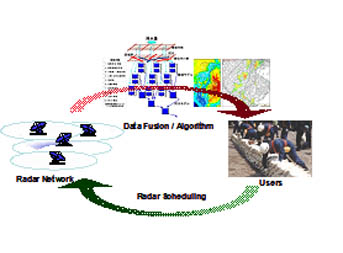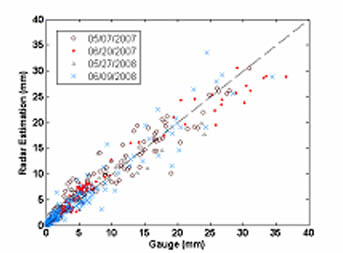QPE Demonstration in IP1
CASA had implemented a radar based quantitative precipitation estimation (QPE) system in IP1 during the 2008 Spring Experiment and the system has been under operational evaluation since then. Radar QPE has been the biggest challenge for weather radars since their inception. In the IP1 radar network, Kdp (specific differential propagation phase) based QPE is very appealing, because of the enhanced Kdp value at X band (compared to S band) and the insensitivity to absolute calibration errors. The Kdp based rainfall rate estimation and hourly rainfall accumulation were produced in real-time from the network observations of IP1 radars. Radar rainfall mapping can be further improved from composite Kdp field from the radars with the lowest beam height and the shortest slant range, or from the radar with the best Kdp estimates, as radars view the precipitation from different directions. The performance of the IP1 rainfall product was evaluated for all major rain events using the USDA Agriculture Research Service's gauge network (MicroNet) in the Little Washita watershed, which is located in the center of the test bed. The cross-comparison with gauge measurements shows excellent agreement. The hourly rainfall estimates compared to the gage measurements has a very small bias of 4.6% and a normalized standard error of 21%. The instantaneous rainfall estimation is also good due to the superior resolution of the IP1 observations in both space and time. The performance data encourages the application of X-band radar QPE for flooding monitoring. Flooding is one of the most common natural hazards and urban flood monitoring and warning is one of the biggest challenges in some populous metropolis. Installation of DCAS radar networks in an urban setting for rainfall application seems very viable.

Evaluation of IP1 hourly rainfall estimates and the plan for urban rainfall application and flooding warning.

|